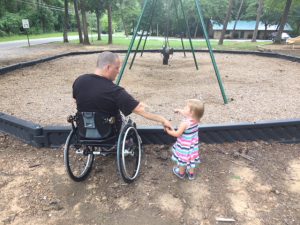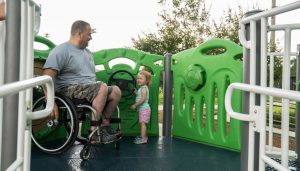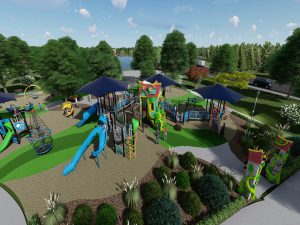By: Kelly Bonner, The National Center on Health, Physical Activity and Disability, and Dee Nance, CTRS Community Service Officer Hoover, Al.
Playgrounds are a time honored tradition and a beloved part of everyone’s childhood. Research shows that the benefits of play are enormous on childhood development and physical activity levels, not to mention playgrounds are just fun. When I ask my two-year-old if she wants to go to the playground, her face immediately changes to one of pure delight. We all want to bring our kids joy and support their health; however, including my entire family in this activity may not always be an easy thing to do – especially in our neighborhood. The reason? Accessibility and design.

You see, my husband uses a wheelchair, and the closest park is far from accessible. In order for him to be able to join us, we have to drive to another part of town to enjoy an accessible playground. Even with accessible playgrounds, it’s not always a given that families will be able to truly play together and share experiences. Many playgrounds merely provide access, but don’t fully embrace universal design or consider the safety features that are located around the playground. For example, if my daughter can access an area that is not accessible to my husband such as parts of the parking lot, play area, or restroom, then my husband can’t take her there regardless of the accessible playground space provided.
Creating Inclusive Playgrounds
Playcore has created the 7 Principles of Inclusive Playground Design called Me2 based off of the 7 Principles of Universal Design. The principles include standards like being fair; providing equitable opportunities for play, and being included and allowing access flexibility so children can choose how and where they want to go. When thinking about building a playground, universal design is certainly where you should start… but you can’t just stop there. Hoover, Alabama, located just outside of Birmingham, found that checking the box and addressing each of those 7 principles did not guarantee that they met the mark when it came to providing access and inclusion in a playground setting. Hoover learned that there are other steps that must be taken to ensure true universal design so that all individuals can be physically and socially active through playground use.
Practice Makes Perfect

In 2015, Hoover Parks and Recreation designed and built Hoover East Playground using the Me2 Principles of Inclusion. They worked with the playground equipment company and architect to make sure that they addressed each of the 7 principles. Once they opened the gates, they quickly found a list of things to avoid and others that had to be changed immediately.
One immediate concern was the placement of the play structure access ramp. The ramped structure exited behind a bay of four swings, creating a safety concern. “On the ribbon cutting day, we watched children play and held our breath. Within a week, the swings were changed from belt swings to toddler swings because of the smaller safety zone required,” stated Dee Nance, former Superintendent of Hoover Parks and Recreation. The department then needed to provide belt swings somewhere else, requiring additional space, construction time, and financial costs.
Going Beyond the Checklist
Despite using an inclusivity checklist, Hoover Parks and Recreation created a play environment that did not provide equal opportunities for all. Luckily, their story doesn’t end here. Hoover recently broke ground on a new development with the goal of creating the largest local universally designed inclusive playground to date. To make sure Hoover addressed every inclusive aspect, the Parks and Recreation department worked with local experts and various disability groups to note what individuals look for in inclusive playgrounds. Including organizations and individuals with a disability from the beginning ensures that the final product will work for everyone.
 Set to open in early 2019, Hoover’s new universally designed inclusive playground will boast a large play area that includes an accessible splash pad, playground, walking path, and changing rooms unmatched in this area.
Set to open in early 2019, Hoover’s new universally designed inclusive playground will boast a large play area that includes an accessible splash pad, playground, walking path, and changing rooms unmatched in this area.
Frank Brocato, Mayor of Hoover said, “This park will become a destination location because of its inclusive amenities. Children and adults alike will be able to play and interact with others regardless of their ability. Located at a large multi-sports complex, this new playground and splash pad are sure to attract thousands because here everyone will be able to come together and play.”
Inclusion Benefits Everyone
Universal design is the way to go when designing outdoor spaces. It allows for welcoming, inclusive, and fun environments where all individuals can participate and enjoy the outdoors. Including people with disability on the planning process is the icing on the cake. The new play space in Hoover will allow my family to play together while building memories for years to come. All communities should seek to do the best they can when providing access and not just what checks the box. Consider going beyond the checklist to ensure a barrier-free and safe place for all community members to enjoy. As the saying goes, “Nothing about us without us.” Be sure to invite everyone, disability organizations, people with disability and/or their caregivers, to the conversations when designing pieces intended for their use.
Spread the word! Share this post with your network using this sample tweet: Go beyond the checklist to ensure that EVERYone has access to play. Learn how practice makes perfect when designing an accessible playground environment, in this Be Active Your Way blog post from @NCHPAD. https://bit.ly/2MQqrWe